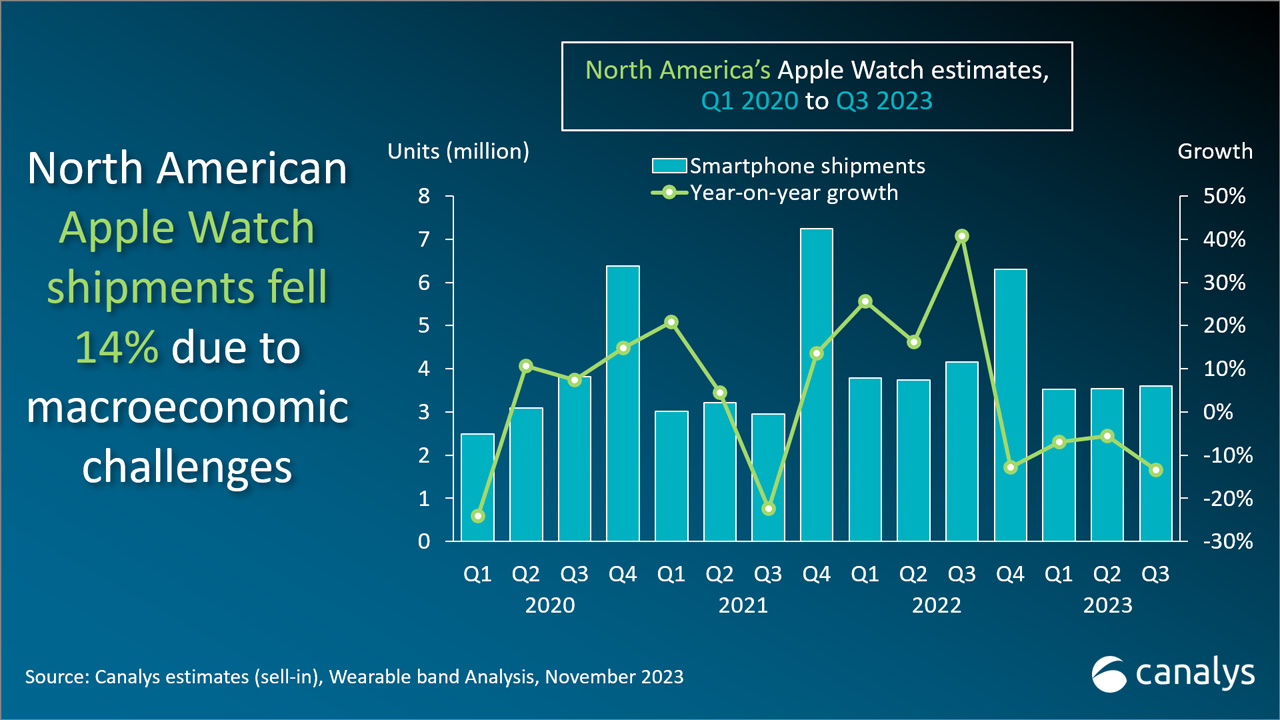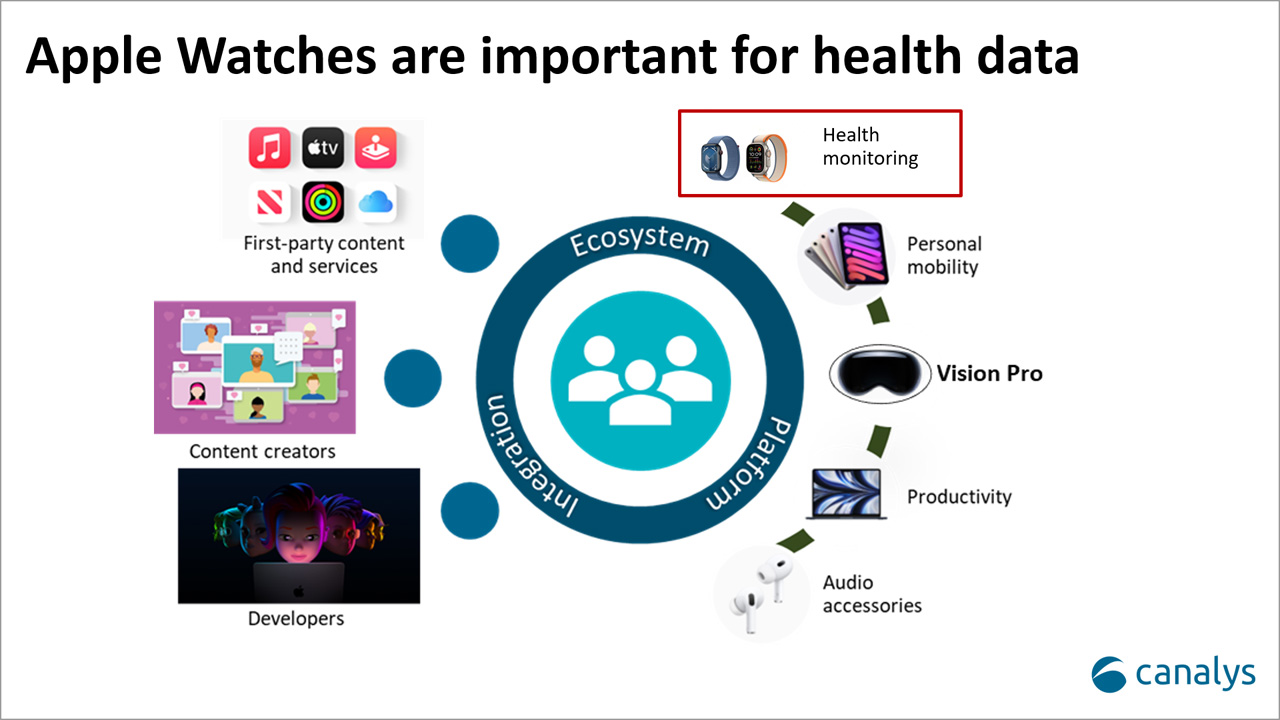Xiaomi’s first Wear OS smartwatch marks a change in strategic direction
11 January 2024
Canalys is part of Informa PLC
This site is operated by a business or businesses owned by Informa PLC and all copyright resides with them. Informa PLC’s registered office is 5 Howick Place, London SW1P 1WG. Registered in England and Wales. Number 8860726.

This blog discusses the recent ban on Apple Watch imports into the US and its impact on Apple’s ecosystem and market share. It also explores the strategies and growth projections of competitors, such as Samsung, Google and Garmin. Additionally, the blog examines Apple’s strategic outlook and potential solutions to navigate the ban, including developing proprietary sensor technology.
.png)
In the wake of the initial limitations imposed by the ITC on the sale of the Apple Watch 9 and Watch Ultra 2 in the US, the ban has escalated to an import prohibition. Consequently, despite Apple’s efforts to buy time, after 12 January 2024, the import ban will resume, and Apple will only be able to ship whatever stock it has left to the retailers. Additionally, Apple will be unable to provide out-of-warranty repairs for the Watch 6 and newer models with SpO2 sensors in the country. This development not only disrupts recent shipments but also jeopardizes the coherence of Apple’s established ecosystem, confining sales to the Watch SE only.
The US market stands as a cornerstone for Apple, accounting for a significant 42% of its global Watch shipments, with 11 million Watches shipped between Q1 and Q3 2023. The ban would hit Apple’s shipments into the US, and this would provide an opportunity for vendors such as Samsung and Garmin to establish themselves during this moment of weakness for the tech giant.
Apple Watches’ role in the ecosystem
Canalys estimates between Q1 2023 and Q3 2023 show a correlation where, in the US, for every 100 iPhones shipped, Apple shipped 21 Apple Watches. In contrast, Samsung shipped 17 Galaxy Watches for every 100 smartphones priced above US$350. This underscores Apple’s concerted efforts to fortify the integration of its IoT devices alongside iPhones, bolstering overall revenue streams.
The attachment rate of iPhones and Apple’s IoT products remains unparalleled in the industry. With the iPhone serving as the linchpin of the iOS ecosystem, Apple employs innovative services and software to streamline interaction and control among diverse IoT gadgets for users and their families. This approach not only enhances cross-device connectivity but also amplifies the capabilities of each gadget, differentiating them in their respective categories and elevating their attachment rates.
The ban, if unresolved, would hit shipments of Apple’s devices into the US in 2024. Canalys estimates more than 6 million Apple Watch 9 and Ultra would be affected in 2024, which could amount to more than US$3.5 billion in sales should the ban persist. Restrictions on Apple’s offerings beyond the Apple Watch SE (2nd generation) are expected to seriously hurt the brand’s carefully nurtured premium image. Given how Apple devices are reliant on the brand’s halo effect, a ripple effect would hurt sales of iPhones, Macs and AirPods.

Market dynamics shift amid Apple Watch ban: competitors’ strategies and growth projections
The recent ban affecting Apple’s Watch product range signals a major upheaval in the smartwatch market. This setback in Apple’s strategy opens a window for competitors to capitalize on, prompting them to bolster their strengths and investments to attract consumers and strengthen their own brand identities.
Samsung and Google, despite suffering a 32% and 16% shipment decline respectively in Q3 2023, are gearing up for a resurgence. Their game plans involve a resurgence fueled by aggressive retail tactics and substantial marketing investments. Their strategic focus revolves around promoting smart home functionalities alongside the launch of high-end products, a calculated move to leverage the temporary weakness within the iOS ecosystem and boost their own market presence.
Contrary to the downward trend seen by some major players, Garmin emerges as a standout performer with a commendable 10% year-on-year growth in Q3 2023. The brand is poised to capitalize on its niche in the health-centric market to exploit Apple’s weakness. Garmin’s latest offering, the Venu 3, boasts an array of features, including ECG tracking, sleep monitoring, speaker and microphone enhancements, and improved battery life. These advances are strategically aligned with the prevailing health and wellness trends, positioning Garmin favorably to capture further market share in North America. Leveraging its robust brand image and existing user base, Garmin aims to drive substantial value gains.
Apple’s strategic outlook
Canalys forecasts a conservative 10% increase in Apple Watch shipments to 40 million units in 2024, lowered from the previously expected 16% growth, contingent upon a potential Watch SE 3 launch in Q2 2024. Additionally, the much-anticipated Watch Series 10 is expected to bring major demand, given Apple’s historical emphasis on its generation X/10 models. In a competitive market landscape, Apple faces challenges, further compounded by apparent reluctance from the White House to intervene in the ban.
In maneuvering through this challenge, Apple could pursue amicable agreements with Masimo or work out ways to minimize the ban’s effect. One potential solution for Apple would involve a short-term software update that disables the SpO2 feature, providing a temporary solution while a more lasting fix is developed for future models. Another approach could entail crafting Watch 9 or Ultra 2 versions tailored exclusively for the US market, omitting the SpO2 functionality. But this route would demand considerable resources due to the necessity of designing and introducing a revised model.
It is difficult for Apple to simply remove the SpO2 function from future Apple Watches and call it a day. The Apple Watch, known for its health features, must keep innovating to stay ahead for health-conscious users. In designing its next generation of Apple Watches, Apple needs new sensor tech to power health apps, studies and collaborations with medical institutions. This innovation is key for the Apple Watch to remain the leader in health tracking. By pushing boundaries with fresh sensors and functionalities, Apple can ensure it remains the go-to device for health enthusiasts. As a workaround, the tech giant has the resources to develop its own proprietary sensor technology and solve the ban issue in time for its next launch, which may serve to bring larger improvements to its “Apple Watch X” and help it end the year on a strong note.
There are several possible solutions to the Apple-Masimo dispute. Apple might opt for a settlement with Masimo or, as mentioned above, explore a software workaround to bypass the hardware issue as a temporary fix. But the more likely possibility is that Apple could choose to delay the ban for as long as possible and use this time to develop its own in-house sensor for upcoming Apple Watches until Masimo’s patents lapse in 2028.